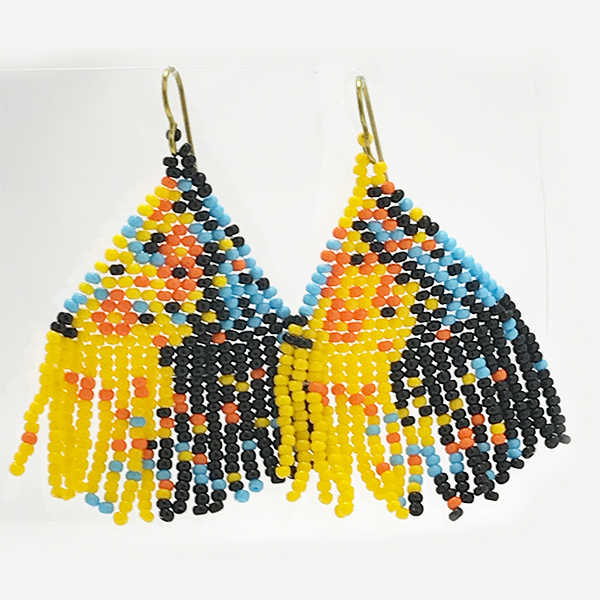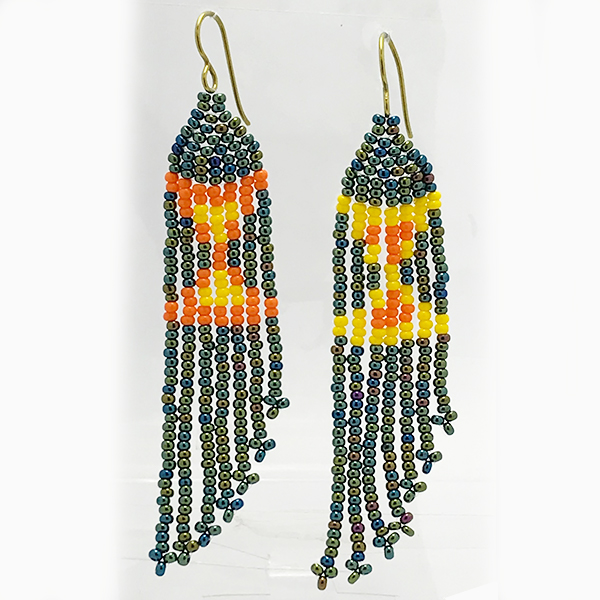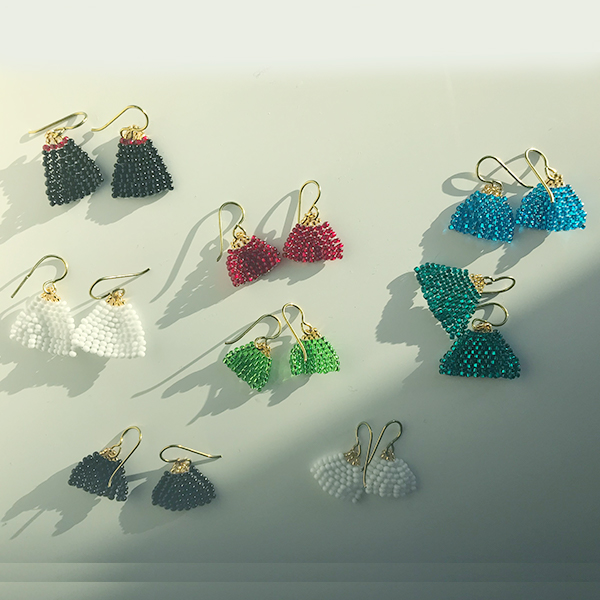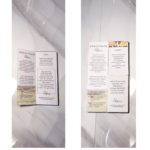BEEDS OF PARADISE
Beeds of Paradise is a project I did from 2018 to 2019. At the time, I was interested in exploring Indigenous art and tradition, entrepreneurship, brand design, product design, and package design. Beeds of Paradise is the foundation of a social entrepreneurship project to help indigenous communities improve their economies and commonwealth in Colombia (as it is the culture I know better) through Jewelry inspired by Indigenous art and Tradition.

The story:
In 2017, I took the opportunity to go to a Festival in Costa Rica called Envision, which changed my perspective radically and sparked a quest that I still can't name but from which this project, and many others, originate. This quest has to do with nature and community. I identify as Colombo-Canadian now. But, before this project, I was still coming to terms with my two homes. I was still conciliating the cultural differences and my experiences in both places. I was still finding/defining my identity and, ultimately, learning to value my individuality.
"This quest has to do with nature and community."

The roots:
I only speak from my experience, and I believe we human beings are artisans; beyond artists, we are artisans. We create and embed meaning, stories, and purposes onto materials. We are artisans.
"We are artisans."
The origins:
Like many other Native American communities, Colombian aboriginal communities have always been proud artisan storytellers who spent a lot of time shaping and forming materials into stories.
The bridge:
From my personal experience, Colombia, among many things, is a country of artisans.
I am from Bogota.
If you go to one's of Bogota's most famous museums, the gold museum, you will find an array of gold art capturing traditions, legends and stories.
If you walk around the old town 'La Candelaria', its colonial structures will have you feeling surrounded by handcrafted ornament and detail.
And, if you want to keep discovering its downtown nuggets, you can head to 'La Septima or 'El Chorro Quevedo', where you will likely find artisans selling their art.
The memory:
Some of my earliest memories of downtown include my mom letting us stop to marvel at the jewellery pieces.
I coincidentally re-felt that joy while reading '100 Years of Solitude by Gabriel Garcia Marques in 2019. As I was developing this project - when he narrates the excitement that Macondo's habitants and story characters felt about the arrival of the gypsies at the town market. I felt that excitement, except my Macondo, was Bogota.
The imaginary:
This shared memory related to the 'artisans' is not coincidental.
This 'artisans' joy lives in the Colombian imagination.
In 2006, Colombian national TV broadcasted a show called 'Merlina Mujer Divina.' The show is a love story about a young jewellery artisan/gypsy woman born under the sign of Scorpio with the potential to become one of the country's best jewellery designers. The show was about destiny, astrology, love, artisans, the jewellery industry, and the same old betrayal and jealousy themes most TV soap operas include. I didn't see the entire show, but the first episodes were enough for me to love the main character and introduce me to the possibilities of design.
The experience:
As time passed and changed, Indigenous Tradition touched my life with its appreciation and care for natural processes and the environment. Over the years and the changes, I continued loving beaded jewellery art. Thus, I was surprised and relieved to learn that North American Aboriginal culture also includes similar art appreciated by many. The truth is that women and men love Jewellery. We human beings viscerally love handcrafted items and art.
Products
















The earrings:
This project started with me making some earrings for myself and then making copies of each pair I made because other people may love them as much as I do and would want to purchase them. While I was doing them, two things became apparent. The first one is that women mainly practiced the activity. The second and most prominent one is that they take a lot of time and require a lot of concentration and patience. As these are time-consuming objects and time is a non-renewable resource, I realized these earrings are high-value items instead of commodities. Sadly, we usually think about Indigenous art only that way. I intended to communicate that my earrings and Indigenous Art were not just beaded earrings. Beeds of Paradise earrings are culture, art, time, and wearable stories and meanings that give their owner a unique identity and are a precious life-long experience.
The representation:
Above myself or their future owner, these earrings represent Native Americans - north, centre and south. It represents our natural consciousness and values regarding nature and us. These ancient cultures hold infinite universal and innate wisdom that I believe we need to understand more. I suspect we must be open to seeing this wisdom through 'Native' eyes while having absolute compassion for ourselves in recognizing the neglect towards nature, these communities, and us. Even though Indigenous communities have effectively managed natural resources, many of these communities have lost and will lose their original settlements due to displacement and changes in environmental conditions. Many of these communities could use stable sources of income to develop their communities further and cover rising needs. In the meantime, we can adopt patterns that will help us create more effective resource management systems; we could help them bridge and integrate their abilities into Western economies. Ergo, at the time and to this day, the ideal vision of this project includes close collaboration and income source creation for these communities, especially for the women of these communities. In the meantime, I committed to donating a percentage of the final product to Indigenous organizations.

The conversation:
I decided I needed to evoke a luxury experience with elegant, fun, sustainable, and meaningful designs. Luxury is about participation, not always the resources required to make it or the status it allows us. Luxury can also be about a significant display and participation of values. As these earrings are laborious and meaningful, I thought their packaging should translate their value and be part of the luxury conversation.
Ergo, I wanted to emphasize the earrings' attractiveness through contrasting packaging that kept the focus on details. I strived for the experience to sound like: 'Dull,' 'texture,' 'sustainability,'' colour,' 'wow,' and then 'details,' 'shine,' and 'personality.' The idea was to create a climbing experience where the user landed in awe and curiosity for the product details and sense of meaning. The materials used to accomplish this conversation were gray cardboard, shiny silver cardboard, and transparent acetate. Gray cardboard communicates sustainability; glossy silver cardboard symbolizes Luxury and the Sun; acetate protects the earring and signals that it is a valuable object. Hence, it is only displayed unless you own it.
The puzzle:
In addition to the materials, the opening of each box has a sequence. It's not just a box without order or purpose. It is different and makes you think. It's a hybrid between a standard package, a little booklet, and a barbie doll box that you must patiently undo from behind. It is a box that seems 'unclosed' at the begging, so you are like, "how do I open it? ahh, I just have to slide it". And then you are like: " WOW! But, how do I take them out". I know this experience initially challenges you but later makes the opening experience much more rewarding once you figure it out. I still wonder whether lego-like instructions are necessary with this opening experience.
The product:
Ideally, the product invites you to question your values, opinions, and courage. It invites you to authentically adorn yourself with the colours of nature through naturally inspired patterns: patterns that can take your evolving meanings and story. That has been my experience with the beaded and Nature-inspired jewellery I made and own. It's been a truly luxurious experience to wear/carry items with such meanings to me, be complemented so often, embody my values, and feel amazing whenever I wear them. They are comfortable, beautiful and humbling as they represent things more significant than me.

The prototypes:
I created three packaging prototypes. The first one failed from the efficiency of production and pricing standpoint as it had a lot of detail. The creation of the packing would need customization and added substantial product cost to a product that requires value definition. The other two embody the same idea, but the second one, although more efficient, has a more significant margin of error. The third one is the most efficient version of the original idea without sacrificing the 'the puzzle' concept.
Education:
The education aspect of this project is vital. Ideally, the project makes you investigate Indigenous community legacy and significance, environmental, community and culture preservation, nature and its regeneration processes, and more. It's important to note that this is not an endeavour of pointing fingers; instead, it is about education. The best learning attitude happens when we shake off our preconceived notions and return to a kid-like state. In that state, we use our experience to navigate the disclosed knowledge with no expectation or judgment but to see how we can integrate it with what we know to be true. This integration can spark intrigue, curiosity, or even disappointment. All evoked emotions are fair and should be accepted. Instinctively, I adopted 'the puzzle' and the booklet-like back of the packaging. I wanted it to be a Christmas-like experience, like opening presents and feeling physically, mentally, and emotionally upgraded. Thus, the back of the product serves as a booklet to embed educational stories. The booklet contained the company and mission on the left, and the product story on the right side to strengthen the sensed identity of the product and brand.

The logo:
The logo has a very intentional form and is anything but abstract. The name of the project 'Beeds of Paradise' inspired it. The logo and name originate from the exotic flower called 'birds of paradise' or 'heliconia.'









